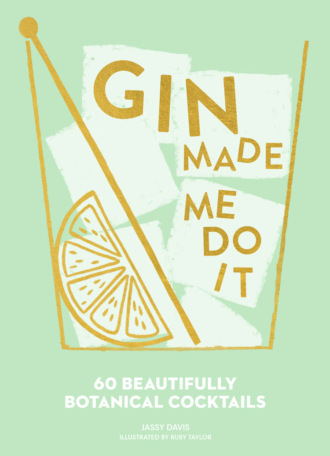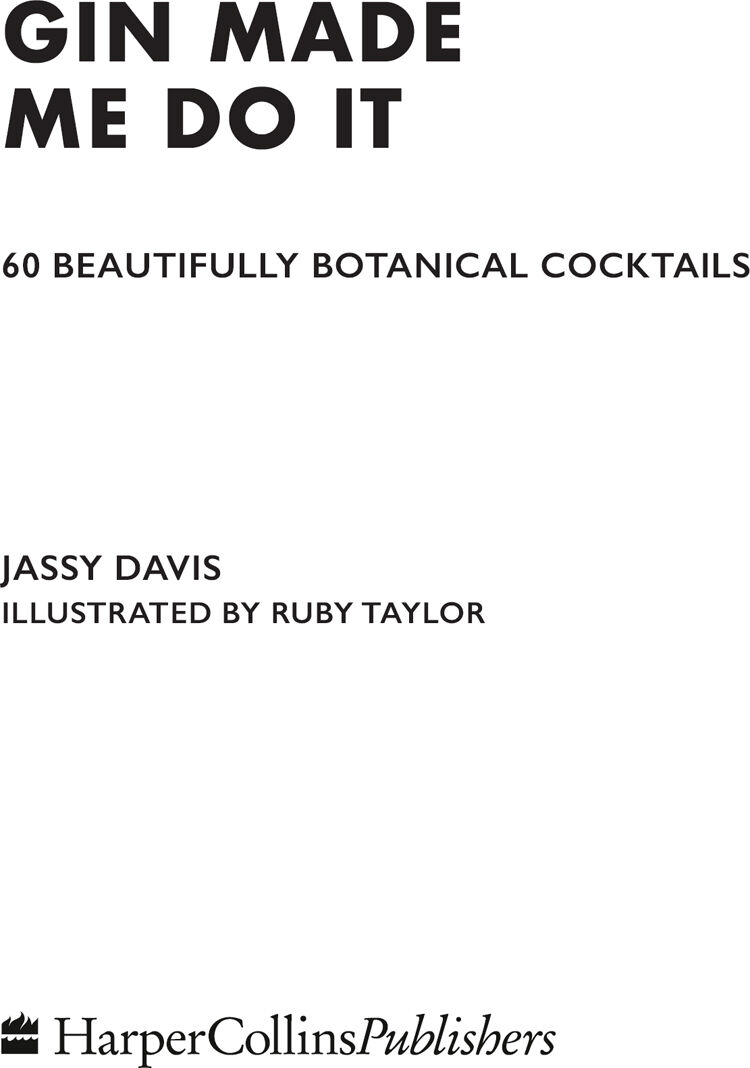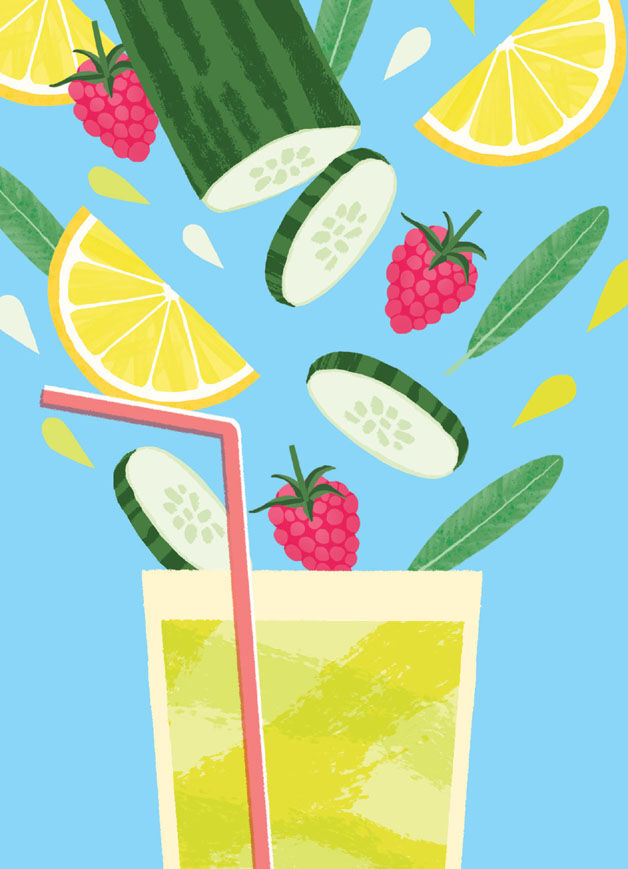
Полная версия
Gin Made Me Do It: 60 Beautifully Botanical Cocktails


COPYRIGHT
HarperCollinsPublishers
1 London Bridge Street
London SE1 9GF
www.harpercollins.co.uk
First published by HarperCollinsPublishers in 2018
Copyright © HarperCollinsPublishers
Written by Jassy Davis
Illustrated by Ruby Taylor
Designed by Gareth Butterworth
A catalogue record for this book is available from the British Library
Source ISBN: 9780008280307
Ebook Edition © December 2017 ISBN: 9780008291792
Version 2018-01-29
This ebook is copyright material. All rights reserved. No part of this publication may be copied, reproduced, stored in a retrieval system, transmitted, distributed, leased, or licensed in any form or by any means, electronic, mechanical, photocopying, recording, or otherwise, without prior written permission from the publisher.

CONTENTS
Cover
Title Page
Copyright
A Short and Scandalous History of Gin
Meet Madame Geneva
Infuse your Booze
The Perfect Martini
The Recipes
Index
Credits
About the Publisher
A SHORT AND SCANDALOUS HISTORY OF GIN
It began with monks – 11th-century Benedictine monks, to be specific. They lived in Salerno, in southern Italy, in a monastery surrounded by rolling hills and juniper trees. And they had a still. A swan-necked alembic still; the kind invented by Abu Musa Jabir ibn Hayyan in Baghdad in the late 700s, and the kind you might find in your local gin distillery today. The monks used it to distil sharp, fiery, alcoholic tonics, one of which was distilled from wine infused with juniper berries. It wasn’t exactly gin – not as we know it – but it was the first recorded juniper-scented spirit.
The monks didn’t consider themselves early mixologists. They were making medicines, hence the juniper. As a medicinal herb, juniper had been an essential part of doctors’ kits for centuries: the Romans burned juniper branches for purification and medieval plague doctors stuffed the beaks of their ghoulish masks with juniper to protect them from the Black Death. Across Europe, apothecaries handed out juniper tonic wines for coughs, colds, pains, strains, ruptures and cramps. These were a popular cure-all. A little too popular, according to some, who thought people were keener to take their medicine than they should be.
THE RISE OF THE DISTILLERY
By the mid-16th century, alchemists had worked out how to distil spirits cheaply from grain. In Holland, good harvests filled the barns and burgeoning trade routes brought spices from South East Asia in incredible quantities. By adding those spices and plenty of locally grown juniper to cheap malt spirit, the Dutch created an inexpensive brew that grew and grew in popularity. They called it genever.
The Dutch took genever around the world, but it was Elizabeth I who accidentally brought it to England. She sent soldiers to help the Dutch fight for independence in 1585 and they returned with bottles of the aromatic drink. The English quickly developed a taste for it, and by 1621, London had over 200 distilleries busy making ‘strong and hot waters’ for a thirsty public. When the Dutch Prince William of Orange landed in Devon in 1688 and marched to London to take the throne, genever’s place in English society was guaranteed.
In 1710, 2 million gallons of spirits were drunk in England and Wales. By 1743 it was over 8 million. Most of it was drunk in cities, and nowhere loved gin more than London, where 90% of all English spirits were distilled. Daniel Defoe, who had written a pamphlet in 1726 for the London Company of Distillers praising malt spirits, complained in 1728 that people were getting ‘so drunk on a Sunday they cannot work for a day or two following’. A gin-fuelled crime wave spilled into the streets and courts. The newspapers were scandalised and the government forced into action.
A series of Gin Acts passed between 1729 and 1738 raised duty on gin and the cost of a distilling licence. Legal gin sales dropped, while juniper tonics made by surgeons became mysteriously more popular and the bootleggers were busier than ever. Informers ran protection rackets, mobs lynched suspected informers, and gin shops sold cheap hooch flavoured with turpentine and sulphuric acid to the gin-crazed masses.
Finally, in 1743 a Gin Act was passed that made a difference. Under it, licences were easier to buy and duty easier to collect. The government gave up on prohibition and the black market gave up on gin. Legal and perhaps even respectable, gin lost its cachet with the drinking classes.
It didn’t vanish entirely though, and in the early 19th century, a round of tax cuts slashed duty on spirits and whetted the public’s appetite for gin once more. Within a year the amount of gin drunk in the country had doubled, and gin drinkers had somewhere new to go to indulge in their favourite spirit: the gin palace. The opposite of a seedy gin shop, gin palaces were handsome buildings, clad in wood and glass, and shining with light. They were oases of warmth and conviviality amid the chill Victorian nights.
COCKTAIL CULTURE
The quality of the gin itself was changing too. The 18th-century ‘Old Tom’ gins had been made in alembic pot stills, which had to be cleaned between batches, and produced rough spirits that had to be disguised with sugar and lots of botanicals. The Coffey still, invented in 1831, could be run continuously and produced a lighter, fresher, more consistent spirit. This smoother, clean-tasting gin came to be known as London dry. Old Tom gin sales declined, and in America, where the first cocktails were being shaken up, London dry was the spirit of choice for martinis, slings and fizzes.
However, America was about to prove that no one ever learns anything from history. The Temperance Movement had been campaigning for a ban on alcohol since the 1820s. In 1919 they got their wish: the Volstead Act prohibited the drinking of any beverage stronger than 0.5% alcohol by volume. As in 18th-century England, so in 20th-century America. Instead of giving up booze, drinkers went underground. In speakeasies, which ranged from dingy rooms with a couple of chairs to spectacular clubs like the Dil Pickle and the Krazy Kat, drinkers kicked back with a heady mix of cocktails and jazz. Gin, easy to make and even easier to mix in strongly flavoured drinks, was riding high. Bootleggers turned industrial spirit into ‘bathtub gin’, while smugglers snuck cases of gin across the US borders. By the 1930s, alcohol-consumption rates were actually higher than they had been in 1919, and it was obvious that Prohibition had failed. In 1933, the 21st Amendment repealed Prohibition, and in the White House, Franklin D. Roosevelt celebrated by mixing martinis.
Post-Prohibition, cocktails moved out of the bar and into the home. Drinks parties were a chic way to mix and mingle, until World War II, that is. Drinkers in the US could still buy good-quality gin and whiskey, but in Britain shortages meant it was back to rough spirits and the taste of turpentine. After the war, gin struggled. A new generation turned to vodka to fuel their fun. Neutral-tasting, easy to drink and supposedly undetectable on your breath, it seemed more modern than gin, with its seedy past and aromatic flavour. Women swapped G&Ts to become VATGirls (vodka and tonics), and by the 1980s, gin was something you only kept around for your aunties at Christmas time.
All seemed lost for gin, until Bombay Sapphire was launched in 1988. Made to a 1761 recipe, boasting ten botanicals and sold in a stylish blue glass bottle, this was worlds away from the fusty bottles of gin the public had got used to. The gin market was suddenly a space where distillers could experiment. In the US, nearly 100 craft gin distilleries opened between 1990 and 2000. In the UK, laws that had stopped small-batch distilleries opening were slowly repealed. Since then, distilleries have opened across the country offering not just elegantly made London dry gins, but craft gins flavoured with hundreds of different botanicals, and even Old Tom gins have had a resurgence.
Gin has been around for more than 1,000 years, but there’s never been a better time to be a gin drinker than right now.
Конец ознакомительного фрагмента.
Текст предоставлен ООО «ЛитРес».
Прочитайте эту книгу целиком, купив полную легальную версию на ЛитРес.
Безопасно оплатить книгу можно банковской картой Visa, MasterCard, Maestro, со счета мобильного телефона, с платежного терминала, в салоне МТС или Связной, через PayPal, WebMoney, Яндекс.Деньги, QIWI Кошелек, бонусными картами или другим удобным Вам способом.


